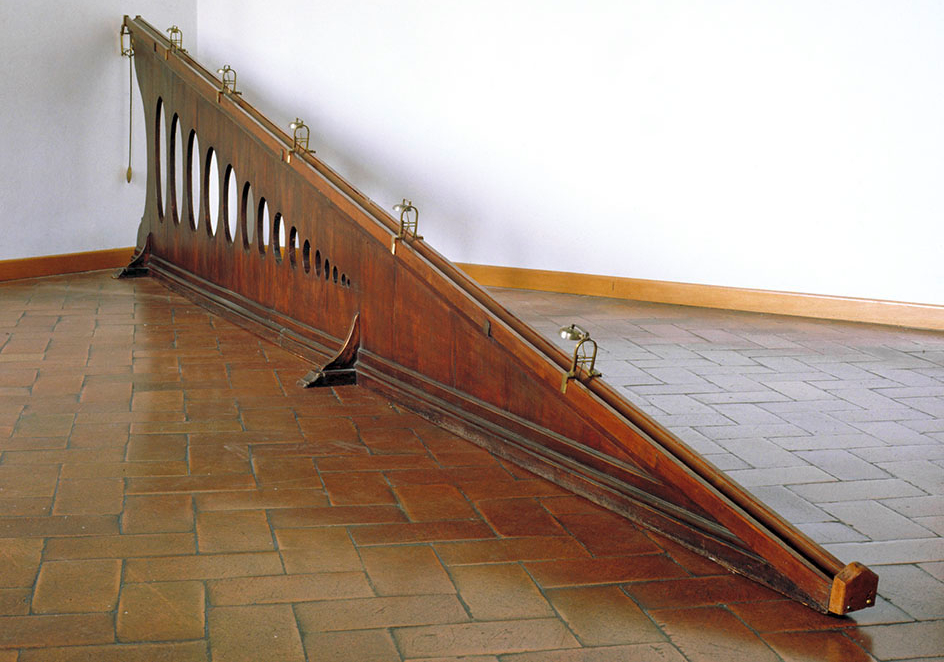Inclined plane
This activity belongs to the GeoGebra book The Domain of the Time.
This animation simulates the motion of a mass on an inclined plane in real-time, disregarding friction. The animation does not use formulas (no trigonometry, equations, or differential calculus); it only makes the necessary variations in the vectors that direct the motion.
A mass, represented by the blue point M, is located on an inclined plane (which includes the distance from the center of mass to the plane). The animation varies at each instant both the velocity vector v (in red) and the position M of the mass due to the action of gravity, whose constant acceleration is represented by the vector g (in dashed green).
The vector g can be decomposed into the sum of two vectors: one parallel to the inclined plane (in green, gt) and another perpendicular to it. This second vector does not affect the motion because its effect is canceled by the support of the ramp, following the principle of action and reaction (Newton's third law). Observe in the diagram that the right triangle with hypotenuse |g| and leg |gt| is similar to the triangle with hypotenuse c and leg b. Thus, |g|/|gt| = c/b.
We adjust the slider script anima:
SetValue(v, v + dt gt)
That is, every time a very small amount of time dt passes, by definition of acceleration, the velocity increases by dt gt.
 You can vary the positions of A and B. After meticulous observations, Galileo discovered that the time it takes for the mass to travel down the inclined plane is the same as that of free fall (let's call it t0) due to the ratio of the distances traveled. In this video (which, like the image, comes from a virtual visit to the Galileo Museum in Florence) you can see a reconstruction of that experiment.
You can vary the positions of A and B. After meticulous observations, Galileo discovered that the time it takes for the mass to travel down the inclined plane is the same as that of free fall (let's call it t0) due to the ratio of the distances traveled. In this video (which, like the image, comes from a virtual visit to the Galileo Museum in Florence) you can see a reconstruction of that experiment.
 You can vary the positions of A and B. After meticulous observations, Galileo discovered that the time it takes for the mass to travel down the inclined plane is the same as that of free fall (let's call it t0) due to the ratio of the distances traveled. In this video (which, like the image, comes from a virtual visit to the Galileo Museum in Florence) you can see a reconstruction of that experiment.
You can vary the positions of A and B. After meticulous observations, Galileo discovered that the time it takes for the mass to travel down the inclined plane is the same as that of free fall (let's call it t0) due to the ratio of the distances traveled. In this video (which, like the image, comes from a virtual visit to the Galileo Museum in Florence) you can see a reconstruction of that experiment.
- Note: This is the case because, at every instant, the speed of descent is the same in both movements (this speed only depends on height: the mass on the inclined plane takes longer than in free fall, but it also travels further), so |gt| t = |g| t0, meaning t = |g|/|gt| t0 = c/b t0. We had seen in free fall that the distance descended was |g|/2 t02, where t0 is the time of descent. Thus, if the mass were to fall freely from A, it would cover b = |g|/2 t02. This means the time of free fall would be . Since following the inclined plane it cover c instead of b, it must be multiplied by the factor c/b, so the total time of travel will be: .
SCRIPT FOR SLIDER anima
# Calculate the elapsed seconds dt; add one second if t1(1) < tt
SetValue(tt, t1(1))
SetValue(t1, First(GetTime(), 3))
SetValue(dt, (t1(1) < tt) + (t1(1) − tt)/1000)
# Move M
SetValue(v, v + dt gt)
SetValue(M, If(y(M + dt v)≥0, M + dt v, B))
StartAnimation(anima, y(M) > 0)
Author of the activity and GeoGebra construction: Rafael Losada.